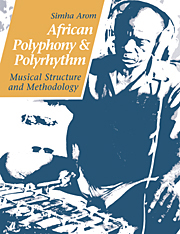Book contents
- Frontmatter
- Contents
- List of illustrations
- Foreword by György Ligeti
- Preface
- Acknowledgements
- BOOK I THE MUSIC OF THE CENTRAL AFRICAN REPUBLIC
- BOOK II AFRICAN POLYPHONIC MUSIC
- Introduction
- 1 A classification of African polyphonies
- 2 Previous studies: the present state of the subject
- BOOK III TECHNICAL TOOLS: METHODS OF RECORDING POLYPHONIC MUSIC FOR TRANSCRIPTION
- BOOK IV THEORETICAL TOOLS
- BOOK V THE ORGANISATION OF TIME IN AFRICAN MUSIC
- BOOK VI STRUCTURAL PRINCIPLES AND THEIR APPLICATION
- Conclusion
- Bibliography
2 - Previous studies: the present state of the subject
Published online by Cambridge University Press: 27 January 2010
- Frontmatter
- Contents
- List of illustrations
- Foreword by György Ligeti
- Preface
- Acknowledgements
- BOOK I THE MUSIC OF THE CENTRAL AFRICAN REPUBLIC
- BOOK II AFRICAN POLYPHONIC MUSIC
- Introduction
- 1 A classification of African polyphonies
- 2 Previous studies: the present state of the subject
- BOOK III TECHNICAL TOOLS: METHODS OF RECORDING POLYPHONIC MUSIC FOR TRANSCRIPTION
- BOOK IV THEORETICAL TOOLS
- BOOK V THE ORGANISATION OF TIME IN AFRICAN MUSIC
- BOOK VI STRUCTURAL PRINCIPLES AND THEIR APPLICATION
- Conclusion
- Bibliography
Summary
INTRODUCTION
Of the principles that may be said to underlie Central African polyphony, some are current in a much wider geographical area, extending from Ethiopia to South Africa.
That is why I have chosen in this summary of previous studies, rather than restricting it to Central African polyphony (which has hitherto been little studied), to devote it to all of sub-Saharan Africa, so as to compare some of the techniques observed or studied elsewhere, both in earlier times and today, with analogous procedures now flourishing in Central Africa. As the reader will see, the documentation concerning this country is very sparse; indeed, out of the hundred or so accounts that I have succeeded in locating, only seven touch upon Central African polyphony. Let me emphasise, nevertheless, that this summary is not exhaustive but is a presentation of the most significant texts that throw light on the subject.
The information available is scattered across some six hundred years. The very first mention of an African musical instrument dates from the fourteenth century, whereas the first description of a performance that would seem to have been polyphonic in character dates from 1497. These descriptions derive from a wide range of sources. They include travellers' tales, as well as the accounts of missionaries, geographers, explorers, ethnographers avant la lettre, members of the colonial administration, stationed in various countries. These witnesses, whether they had any musical knowledge or not, always had an opinion about the music that they happened to hear, and they always gave their aesthetic judgement about it.
What all these witnesses have in common is their attempt to give an account, with varying degrees of astuteness or competence, of performances they had attended, and things they had seen and heard.
- Type
- Chapter
- Information
- African Polyphony and PolyrhythmMusical Structure and Methodology, pp. 45 - 92Publisher: Cambridge University PressPrint publication year: 1991



